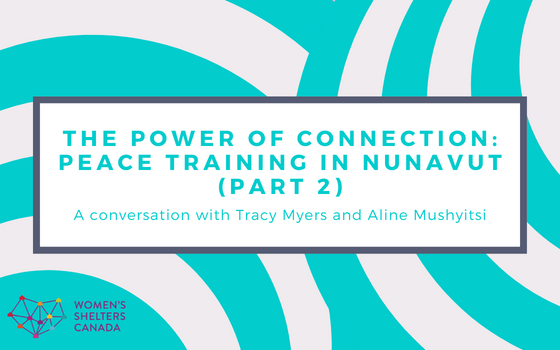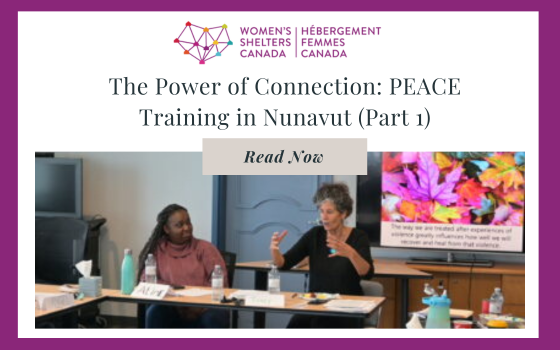Created in 1992 by transition houses in British Columbia, the Prevention, Education, Advocacy, Counselling, and Empowerment (PEACE) Program is a free, confidential, community-based program dedicated to supporting children and youth who have experienced violence at home. PEACE counsellors offer services such as individual and group programming, information-sharing to non-offending caregivers, and anti-violence co-presentations in schools.
Today, the PEACE program has grown to encompass 86 programs led by 150 counsellors across BC. It has also recently seen an exciting expansion through the introduction of a new national three-year project. Entitled PEACE for Canadian Children & Youth, the project is being carried out by the BC Society of Transition Houses (BCSTH) and Women’s Shelters Canada (WSC) and will seek to provide training and mentorship to shelter workers in northern, rural, and remote communities across Canada. Ultimately, the goal is to support these organizations to provide specialized care for children and youth who have experienced and/or witnessed gender-based violence.
WSC’s Knowledge Exchange Coordinator, Chandrabarna Saha, had the pleasure of catching up with PEACE Program counsellor, Tracy Myers, who not only shared her experiences with the existing program, but also her hopes for the new PEACE for Canadian Child & Youth project. Tracy has worked in the non-profit anti-violence sector for over 30 years, with a focus on children, youth, and families who have experienced violence in their homes.
Chandrabarna Saha: Can you tell us a bit about the BC PEACE program and how you came to be involved?
Tracy Myers: The Peace Program is a free, confidential service that’s offered in British Columbia to children and youth who have experienced violence in their homes. It started in 1992, out of the wisdom of transition house workers who saw that children and youth had their own experiences and really needed their own supports to respond in a proper and dignified way. Those workers were pioneers in noticing that children, their bodies, and spirits are impacted when they are witness to and/or experience violence from a caregiver they depend upon.
I became involved through my grassroots anti-violence work in rape hotlines and shelters for women who use substances. While doing this, there was a position that came up in the PEACE Program and my cells just aligned. To walk alongside young people as a survivor myself, to gather with other counsellors and support them, this has been some of the most exciting work I have ever done.
CS: What makes the PEACE Program approach unique and successful?
TM: I do think that there are some fundamental things about the PEACE program that distinguish it from other approaches. At its basis, violence is an attack on a person or a community’s dignity. In the PEACE program, the idea is to really honour and make sense of the way people are responding as very often, their behaviour gets pathologized. The way people respond and make sense of violence is beautiful; it’s resistance. When seen through that lens, you can now really strengthen and uphold their behaviour instead of seeing it as wrong.
I think it’s also specific in honouring the caregiver and child relationship. A lot of services separate children and youth from the family unit and the community, but really, violence in a home disrupts the relationship between child and caregiver. Not only does the mother’s dignity experience violence, but also her dignity in front of her children. Including the caregiver and speaking about the ways they resisted is also a fundamentally different part of the PEACE program in that it acknowledges that everyone is impacted and resists.
CS: How does the PEACE approach incorporate the complex needs of children & youth who are BIPOC, 2SLGBTQ+, and/or living with disabilities?
TM: The BCSTH is made up of a diverse staff of people, who I believe come from a place of humility and wanting to be informed by people with lived experience. This begins by asking questions such as, “How do I respond in a dignified way to someone who may not speak English or may have an experience of state violence that is different than mine?” Or, “How do I connect in a dignified way with the peoples whose land my agency sits on?”
The PEACE approach adopts Intersectional Feminism in a very grounded and rooted way, meaning that depending on my location (my race, sexuality, class), there is a change in the way I interact with these systems. Canadian culture is a story of domination and violence that continues and it is in that kind of a landing where BCSTH starts.
CS: WSC and BCSTH are collaborating to share the PEACE approach with shelters across the country and to adapt it for front-line settings. What are your hopes for this new project?
TM: When I first heard about it, I was excited, then terrorized (laughs). In my own life and past 20 years of this work, I know that isolation and feeling alone is a real threat to us as a species. I think one of my greatest hopes is that people in disparate parts of the country, doing this work, likely unacknowledged and likely unseen, feel supported, empowered, and connected when supporting children and youth with experiences of domestic violence. Uplifted and supported workers then uplift and support the people coming in for services.
In addition to this, so many people are afraid to have conversations with young people about what happened, including their mothers and parents, but in the silence, we miss opportunities to honour how brilliantly they kept themselves safe. That is not a traumatizing conversation; that is an uplifting conversation. In this way, I’m also hoping that the workers feel more solid and less worried about interrupting distress between caregiver and child in the family home.
Part of this program will be built around the separate needs of shelters, so we’ll be gathering information from each particular cohort to see what they’re wanting from this. The hope is to develop a blueprint of promising practices to encourage other shelters across Canada who are interested in enhancing the supports they are able to offer to children and youth with experiences of violence.
CS: What are some concrete uses of the PEACE approach in everyday front-line work?
TM: I think the intersectional lens is a lens to adopt to see that people always respond to violence and resist in some way. It’s up to us to know that and highlight it. I’m hoping that that kind of approach to people who have experienced violence is something that people really start to look through if they are not already. We want proficiency – not deficiency – to be the lens and we want to understand that behaviour is just communication.
CS: What do you, as a facilitator, hope to take away from the training sessions?
TM: Every time I spend time with a group, I walk away so inspired. I think I will learn a tremendous amount about Northern and rural communities and what it is they’re facing as I live and work in an urban centre. I think I will understand more deeply some of the struggles people are facing in a very felt and embodied way. I know I’m also going to be inspired by the incredible creativity and resourcefulness people are meeting those challenges with.
I’m expecting to make some friends and have some laughs. To experience joy with each other, feel deeply, and grow myself in this practice.
CS: If shelters are interested in learning more about this approach, how can they get involved?
TM: If folks are interested to learn more, they can start by applying for the training and mentorship that they can access here! They can also sign up for the WSC and BCSTH newsletters – stay tuned for the promising practices that will be disseminated at the end of the project and visit some of the links below.
- About PEACE for Canadian Children & Youth
- About the PEACE and VIP Programs
- PEACE Program Resources
- VIP Program Resources
- BELIEVE Project
This interview has been edited for length and clarity.





Leave A Comment
You must be logged in to post a comment.